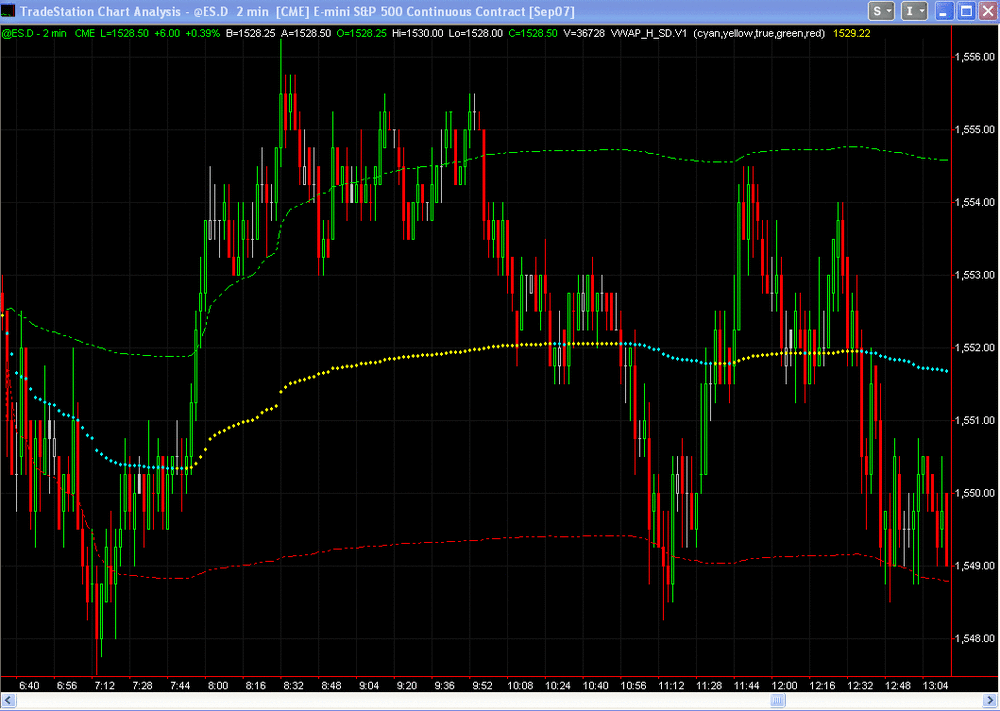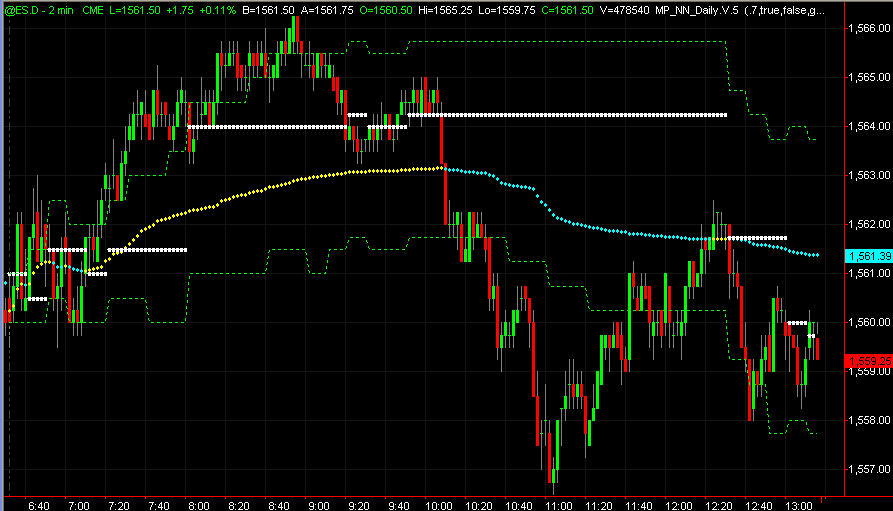Welcome to the new Traders Laboratory! Please bear with us as we finish the migration over the next few days. If you find any issues, want to leave feedback, get in touch with us, or offer suggestions please post to the Support forum here.

nickm001
-
Content Count
94 -
Joined
-
Last visited
Posts posted by nickm001
-
-
understand now... very nice improvement.
Here is another suggestion, if you have not implemented yet... store on every tick... check for new PVP only if the price changed... this is 60% savings and no loss of accuracy. (my initial concern converted into improvement )
-
I think cooter is correct... if there is no change in price ( but trade still happened) is that volume included in the calculation or not? It should be.
Some posts in TWS forums ( think from solidus) showed that 60% of the volume happens with no tick( price) change. This is where the CPU load saving comes from.
-
You should also look at position sizing... Wild swings like that are sure indication that you are probably risking too much of your account on each trade. Try reducing size to 1/2 or 1/3 of what u currently use if the wild swings bother you.
-
I asked the same question several days ago.. Here is the answer:
Feature for ensign software:
Quote:-------------------------------
volume histogram: available
peak volume : available
VWAP : available
SD : not available but can be programmed by user as a DYO
Also if you ask Howard Arrington (owner of Ensign) he would probably make it available if there was enough demand.
My own software is presently not available for general use.
__________________
JERRY
-
I don't want to beat this to death, since the code is performing close enough to what Jerry has. However, it is only important if you decide to expand the code to include volume distribution. At that point you will realize that assumptions made in this code are not valid in all cases. It is accurate observation that the smaller the time frame is, the more accurate calculation becomes, simply because there is an underlying assumption that the volume was constant within the bar interval ( we know the total volume of the bar, and range of the bar). Calculation will be accurate as long as the price does not hit the same level more then once. Now suppose that we have a consolidation day when the price moves back and forth several times thru the range. Every time it comes to the price pi, you will have to add volume of that instance to previous volume at the same price and build volume histogram bar for the price pi. Now when you do calculation for the SD, you would take sum of the volume at price pi and divide it with total volume for the session . I hope that this explanation is better then previous attempts.
-
OK let me try to explain again my understanding of the formula. Let quote what Jerry wrote in his explanation:
QUOTE#######################################
While we won't address all these questions in one thread their answers can be obtained by analysis of the volume distribution function. To do so requires that we introduce a third property of the volume distribution function called the Standard Deviation of the VWAP, SD for short. SD is computed from the following equations:
NOTE : Formula did not copy ... see http://www.traderslaboratory.com/forums/f6/trading-with-market-statistics-iv-standard-2101.html
where the summation subscript i, runs over all prices in the volume distribution
pi = ith price in the volume distribution
Pi = vi/V is the probability of occurrence of price pi
vi = the volume traded at price pi from the volume distribution
V = total volume for the entire distribution
#################################
Note that factor vi is volume traded at price pi. If I understand your code, you have used volume of the bar, or volume at time , not as described in the formula.
To get proper value for vi, you would have to keep track of all the volume distribution at EACH price level of the range in the array and use the value of volume array element that corresponds to price pi. It can be done, but it would take more then few lines of code, unfortunately.
For some odd reason, it does not seem to make much difference even if you set vi/V = 1, for the few sample charts I looked at. So for all practical purposes, SD value is usable...
-
Hi DbnTina,
I am not sure if the calculation for vi is correct.
In your EL you have used
variance_i = ((UpTicks[Value1]+DownTicks[Value1])/ShareW) * (Square(AvgPrice-VolWAPValue));
where (UpTicks+DownTicks) represents volume of the bar ... I think in a probability calculation one should use total volume at price i, not just volume of the bar i. Lets ask Jerry for clarification.
-
Trade Station Users,
Jerry gave good description of SD function and how to calculate it in thread #IV. In the same thread I have posted code for calculating simulated SD, which tracks pretty close with ensign SW and jerry's calculation. Important point is that SD is cumulative calculation with lookback period changing thru the day to always start at the beginning of the session ( basically one has to count bars and change lookback period to include data from the first bar of the day. SD is calculating price distribution around VWAP. What SD calculation is is missing is vi/V factor vi is volume @ price; V is total volume for the session.
-
That is a good news, that volume histogram and peak volume are available. I am not sure if the code for volume profile is open and can be expanded to calculate SD, which would not be too bad of a task.
I am tradestation user. All code for indicators is open, and can be used for further development. It is unfortunate that TS does not provide any of the above tools; user forum provided VWAP.. The rest is DYO.
-
Jerry, Thanks for sharing your experience.
I am not sure if you answered this question before, but is the volume histogram, peak volume, VWAP and plotting SD around vwap something that is part of esign SW or did you have to program those yourself? I have checked esign site and found TPO based histogram, vwap is there, but did not see anything else from your tool set.
-
I don't think it has anything to do with 25K restrictions. I think restriction only applies to equity markets, not futures. Here is the link to rules
http://www.interactivebrokers.com/en/trading/marginRequirements/patternDayTraders.php
Combine accounts give a convenience to spread trade over several accounts. instead of setting 3 trades in each account ( 3x open trade + 3x to close it), you just put 1 trade ( 3x size and it is automatically divided between accounts).
-
Dogpile, breakouts in general, are very difficult to trade. If you backtest them, you will find that they fail 60-70% of the time. Money can still be made, but you have to make sure that you lose a little when it doesn't work and stay with the trade for long shot when it does.
-
IB has it... It is called financial adviser account. You can pull together IRA, ROTH and CASH accounts under one control... and trade them just as if they are one account. Trades are automatically split between accounts based on pre-defined % or ratio. You would trade thru master account, that sits like umbrella over all sub-accounts. pretty neath feature.
-
Hey Frank, I have posted my code in Tradestation forum for calculating cumulative SD of the price , centered about VWAP. This gets you closer to what Jerry is talking about.
https://www.tradestation.com/Discussions/Topic.aspx?Topic_ID=66875
-
I think I understand your point.... but it also is not good news from the point of calculating SD, since one has to save values for volume at price ( or whatever unit one will use) for calculating the vi/V element. This makes coding VWAP SD as complex as MP - not a good news for NEWBE:sad:
I have come up with crude approximation of SD, by dropping vi/V factor, and it is remarkably close to your pic for July 23rd for whatever it is worth. See the pic attached
-
Jerry,
I am also confused with
"Also each of the terms in the sum should be the same VWAP" statement.
Vwap is developing during the day, and is a sum of (pi * vi)/ V. It would seem that SD equitation should have VWAPi and be summed at each bar. So one would get distribution of prices in reference to VWAP line.
-
For whatever it is worth, I have noticed that POC and PVP come withing few ticks in most cases. My thoughts are that they are very similar in shape and peaks are almost aligned. Exceptions are trend days and double distribution days when POC can pick one side and PVP the other.
If you were to plot globex and day session (24h) then definitely you wanna use volume distribution, or the MP would preference off hour session ( more time) and create unjustified peaks corresponding to low volume.
-
-
My experience with IB was quite the opposite. I had an order that executed in error. I was modifying already existing stop/limit order, and because of the bug in IB software another parameter of the order got changed, causing immediate execution.
I closed the order as soon as I noticed ( within minutes), but the loss was already ~$300. Then I called technical support and reported the error. During the support call he was able to replicate the bug.
I have documented the error, filed request to be compensated for loss and received FULL compensation ( loss + commission )...
My rule is simple- if the trade is wrong - CLOSE the trade first and limit damage.. then you have all the time in the world to analyze, report and complain.
Disclosure: I have both TS and IB. I do 10 RT in TS to get platform cost free and trade mostly with IB. I like IB universal account that lets you trade just about anything from the same account - Stocks, futures, etc.
-
The SEC has approved amendments rule 10a-1 to remove the "short sale tick test" requirement effective Friday, July 6th, 2007.
Effective Friday, July 6, traders will be able to short all securities without a required up tick, up bid, or short exempt designation.
Please refer to the following for additional information:
http://www.sec.gov/rules/final/2007/34-55970.pdf
-
Assuming that you like IB platfrom for trading, and are looking to supplement it with charting SW, I would search for charting SW that is compatible with IB data feed, like:
http://www.quotetracker.com/index_nn.asp
or
Tradestation offers far more then just charting, ability to program your strategy and back test it, auto execution, etc.
-
if you are incline to code, Antonio published an early version of his MP code in this thread at TSW. It plots composite profile histogram, but is missing ValH/L and POC
-
we are both correct (imagine that! )... pending on how the chart is setup...
""""""""""""""""""""""""""""""""""""
The keyword "Ticks" with "Trade Vol" selected shows the number of contracts traded over all transactions during the bar.
The keyword "Ticks" with "Tick Count" selected shows the number of transactions occurring during the bar and ignores the number of contracts traded.
"""""""""""""""""""""""""""""""""""""""
and for detailed explanation see the following link
-
The explanation that I heard is that floor traders talk about "Opening range" that refers to just the few ticks range that market opened at. It can be approximated closely as first minute bar range.



editing the post hangs
in Announcements and Support
Posted
I had the same problem here torero... use the "advanced" version instead. Quick reply also seems to hang.